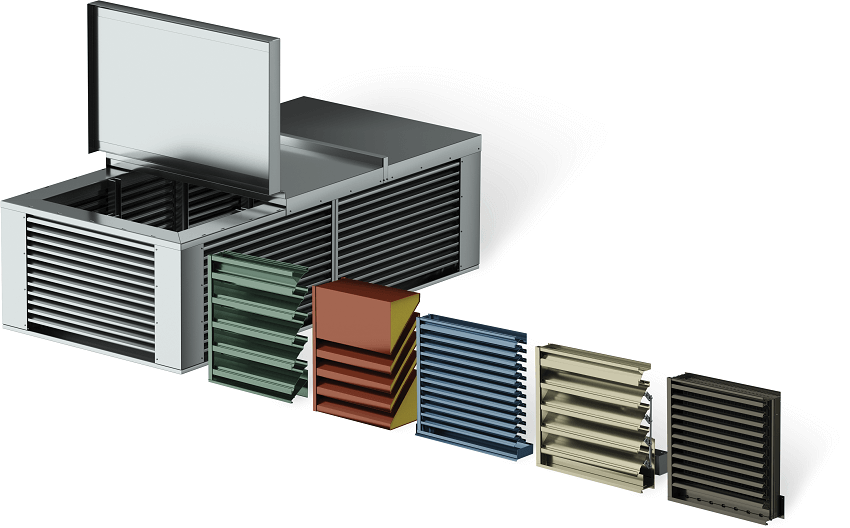
What exactly is a louver? What is its function in a building and an HVAC system? Simply, a louver is a device comprised of blades that permit the flow of air but inhibits the entrance of water or other elements. But simple doesn’t truly get at the form and function of louvers. Selecting the correct louver for your application can be complex. In the first of our Louver Fundamentals series, we break down how a louver works and what types of louvers are available.
Louvers are essential to a building’s HVAC system as they allow for air intake and exhaust that helps ensure the HVAC system is operating at its peak. In addition, louvers also create resistance to rainwater or hurricane-type winds, reducing the need for costly repairs to air handling equipment and building interiors from potential weather damage.
What makes up a louver?
Louvers are comprised of the following parts:
- Head – the horizontal part of the frame at the top of the section.
- Sill – the horizontal part of the frame at the bottom of the louver section.
- Jambs – the vertical members at the ends of a section that prevent water from being blown in; these often have built-in channels to help water drain quickly away from the face of the louver.
- Blades – horizontal or vertical spaced slats making up the body of the louver panel to allow airflow.
- Mullion(s) – the intersection of where multiple louver sections meet. They are either hidden or visible. In a hidden mullion system, the blades provide a continuous blade appearance. In a visible mullion system, the mullions are visible where the jambs meet when installing two sections side by side.
What are the most common types of louvers?
Application is a critical component of louver selection. Before selecting, let’s review the types of louvers available and their typical applications.
Stationary or Fixed Blade
Stationary blade louvers are used in intake, exhaust and ventilation applications and offer considerable design flexibility. They are best used in applications requiring low to moderate rain and weather infiltration protection. However, these lend little protection against wind-driven rain and provisions for water should be considered. Conventional stationary louvers offer high free area and low airflow resistance and are generally the most economical option.
Adjustable or Operable Blade
Operable louvers have blades that can be opened and closed and are most often supplied with factory-mounted and adjusted electric actuators. When in the open position these louvers function as a conventional louver. When in the closed position they provide a tight shutoff from air and other elements. These louvers provide good protection against rain infiltration under ambient conditions but lend little protection against wind-driven rain when in the open position.
Combination Louver/Damper
Combination louver/dampers protect air intake and exhaust openings in exterior walls. The design allows for fixed louver blades in the front with operable damper blades in the rear that may be open or closed while maintaining a louver appearance from the front. Common applications for combination louver/dampers include warehouses, distribution facilities, and manufacturing plants where you want air control without the use of a damper.
Wind-Driven Rain
Wind-driven rain louvers are high-performance fixed blade louvers featuring a drainable head and either horizontal or vertical rain-resistant blades that minimize water penetration through openings that are sensitive to rain penetration. Wind-driven rain louvers offer far superior protection against driving rain when compared to conventional louvers. Horizontal blade wind-driven rain louvers perform extremely well, but vertical blade products offer the best performance considering both weather resistance and airflow performance. These louvers are commonly applied on data center projects.
Other louver types include hurricane louvers and other specialty louver application products such as acoustical louvers and penthouses that act primarily as open draft weather enclosures over various types of exterior fan arrangements.
In addition to the exterior building design and aesthetics, consider the site position, exposure, and prevailing weather conditions when selecting a louver type. Our next Louver Fundamentals blog post will explore louver performance criteria and selection considerations.


from